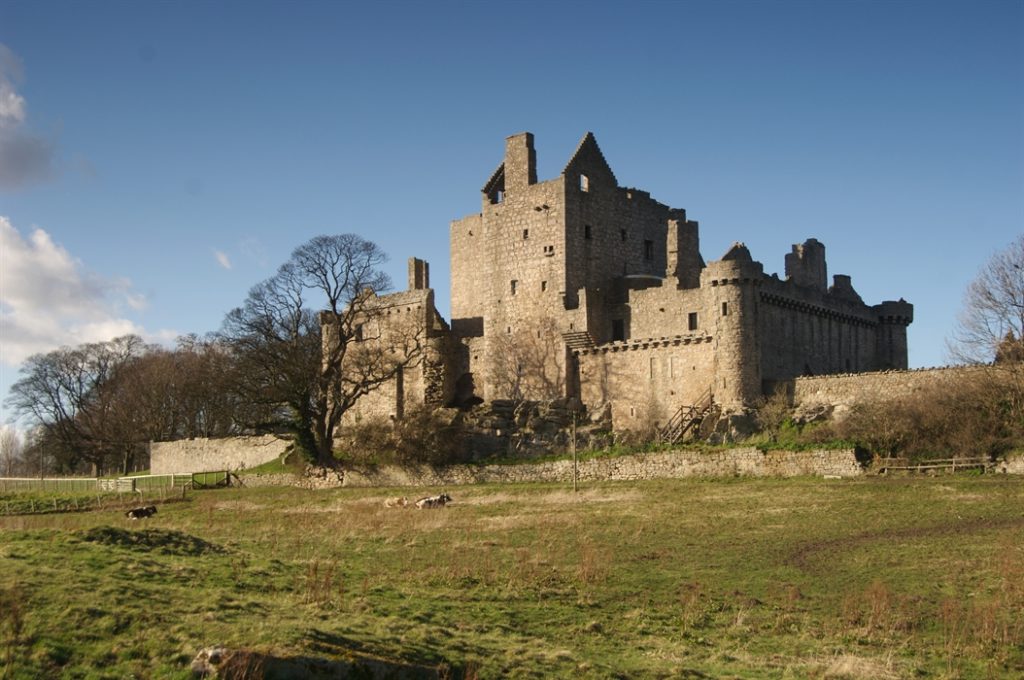The oldest part of the Castle of Craigmillar still standing was built sometime during the late medieval period. Constructed upon a crag of rock on the crown of a hill is a fine example of a traditional Scottish keep.
Built by an important Scottish family of the period, the Prestons, an L-shaped tower rises from the base of the 20 foot scarp to a height of 90 feet. It comprised four storeys consisting a lobby and large basement on the ground floor, lower loft and guard chamber on the first, great hall, kitchen and closet on the second floor and, on the upper floor, upper loft and chamber . Within the roof was a further chamber. Little evidence exists as to a precise age for the tower.
Sometime during the mid 15th century a quadrangle, the inner curtain wall, was built around the tower as fortification, the southerly wall being laid flush with the southern face of the keep. At each corner are machicolated towers standing 30 to 40 feet tall and pierced with inverted gun loops.
Along the top of each wall are crenelated parapets. Adjoining the tower was built the east range adding extra chamber rooms. Further timber buildings originally stood within these walls, there still existing various evidential features such as windows and protruding corbels.

Surrounding the castle were, to the south, an ornamental fish-pond carved in the shape of a P, and to the west, probably constructed in 1510, according to a date plaque above a leading entrance, the terraced west garden.
To the east, the east garden, and within, a small chapel built sometime in the early 16th century. Outer walls to the east, north and west were constructed enclosing the east and west gardens and forming a new outer courtyard of some 1 1/4 acres. These walls are, in places, 28 feet high and 5 feet thick. At the north east corner was built a dual purpose defensive tower and dovecot.
Shortly after its destruction in 1544 much of the castle was rebuilt and improved upon by Sir Simon Preston. At this time, there was now an extra kitchen and five further chamber rooms in addition to rooms within the keep. During the following years a favourite resident to Craigmillar was Mary, Queen of Scots.
Shortly after Sir John Gilmour purchased the castle in 1660 he undertook an extensive programme of rebuilding. A new west range was constructed and a turnpike added connecting the tower. Buildings adjoining the inner court wall now consisted two storeys of some 15 rooms including a drawing room, two kitchens and several chambers. In 1687, a church was built within the north west corner of the outer courtyard.
The castle was largely abandoned towards the end of the 18th century. Later, in 1884, Captain Gordon Gilmour, a relative of the aforementioned Sir John, spent a considerable sum toward preserving the ruin. Today, the castle is in the care of the state and managed by Historic Scotland.
Early History
Very little is known about the early history of Craigmillar. Nor of it’s castle.
History does tell us that sometime around the mid 14th century the lands passed into the hands of an important scottish family, the Prestons, from a John or William de Capella.
But who was Capella? – A medieval monk? – Possibly he had links with the previous owners, the Holy Trinity of Dunfermline – We may only surmise.
Medieval Times
In 1346, Sir John Preston was granted the nearby lands of Gorton, some 4 miles to the south, by David II. He had been a prisoner alongside the king during the Battle of Durham. And, at some point, this previous tenant had ‘surrendered’ the lands of Craigmillar.
Then, in 1374, the barony of Craigmillar passed to the Prestons of Gorton when a charter was received by Sir Symon Preston, son of Sir John, from Robert II to hold the lands as an hereditary fief. Another account notes that the lands were ‘purchased’ by Sir Symon Preston in 1374. It isn’t clear precisely when the castle was built. One account accredits the building to Sir John Preston in 1365.
Surrounding Areas
In any case, by the late 14th or early 15th century, an impressive castle had arisen around a large tower. It was built upon a crag of rock on the crown of a high hill. A better vantage point could not be had, there being a panoramic view of the surrounding countryside including Edinburgh and its castle, for many miles in all directions.
The Prestons remained guardians for nearly 300 years making successive improvements and adding various fortifications to the great tower and castle.
Surrender
The castle walls were breached on at least one occasion, in 1544, by an attacking army, the Earl of Hertford’s English army, during Henry VIII’s campaign of Rough Wooing. The then laird, Sir Simon Preston (IV) had been forced to surrender against impossible odds. Some time later, in 1572, during the siege of the Castle of Edinburgh, Craigmillar was garrisoned by troops of the Regent Mar.
Conference
In 1566, the infamous Conference of Craigmillar took place at the castle in which a group of noblemen, loyal to Mary, Queen of Scots, conspired to murder her husband, Lord Darnley. They entered into a pact, The Craigmillar Bond, pledging equal desire, and responsibility, to ‘put off by ane way or another’ the tyrant Darnley.
The Castle
The basic dimensions we see today (albeit, now, of a skeletal ruin) are of those that must have been shortly after the fiefdom changed hands, in 1660, to Sir John Gilmour. He quickly undertook extensive restorative and rebuilding work, particularly to the west range, and brought the buildings more into line with 17th century living.
The castle then stayed with the Gilmour family until 1775 when Sir Alexendar Gilmour, great grandson of Sir John, moved to Inch House in the district of Gilmerton, so named after his family.
Today
Over the next 170 years or so, the castle was left to its own devices and fell into a state of disrepair. Since 1946, this important medieval castle has been in the care of the state and held in trust by Historic Scotland.
Craigmillar Conference
Married to Lord Darnley, Mary Stuart, Queen of Scots, had been, by most accounts, subject to a horrendous period. After she was made to witness the murder of her secretary, Riccio, her advisers had decided that something need be done.
A conference was held at Craigmillar Castle. Shortly afterward, Lord Darnley had been blown up at Kirk-o-Fields.
The conference, famously known as The Conference of Craigmillar, between Mary and her nobles, regarded the problem of Lord Darnley and took place some time toward the end of 1566. Attending were Lethington, Argyll, the Lord Justice, Bothwell, his cousin, Sir James Balfour, later, President of the Court of Session, Huntly, the Chancellor, and Maitland, the Secretary, the former acting as spokesperson.

A divorce had been proposed though this was rejected by the Queen: “Her Grace answerit, that under twa conditions she might understand the same – the ane, that the divorcement were made lawfully; the other, that it war not prejudice to her son – otherwise her hyness would rather endure all torments, and abyde the perils that might chance her in her grace’s lifetime.”
Resulting from the conference was a bond signed by four of those present, namely, Argyll, Huntly, Maitland and Bothwell (or so it was to be alleged).
The bond, known as The Craigmillar Bond, stated, to the effect, “That forsaemickle it was thought expedient and maist profitable for the commonwealth, by the haill nobility and lords under subscryvit, that sic ane young fool and proud tyrant suld not reign or bear rule over them; and that for divers causes, therefore, they had all concluded that he suld be put off by ane way or another – and whosoever suld take the deed in hand, or do it, they suld defend and fortify it as themselves.”
This, taken from an account in the Pitcairn’s Criminal Trials, cited from memory by the Laird of Ormiston during a confession for his part in the murder.
The Murder of Lord Darnley
Lord Darnley had been recovering from a spell of smallpox in Glasgow. At the behest of his wifeit was suggested he should continue his convalescence in the fresh air and ‘pleasant’ surroundings of Craigmillar Castle.
This had been the plan. But at some point Darnley changed his mind and had begun to suspect some danger and, upon advice from his circle, and, not least, considering the evil deeds that had previously befallen the Earl of Mar, had instead returned to one his town houses, Kirk-o-Fields, just inside the town walls.
Only a few months after the murder of Darnley, the Queen married Bothwell, a leading actor, it was generally regarded, in the plot. The Laird of Ormiston, having been convicted of the murder at a trial six years later, had made a confession during his last moments such that Bothwell had spoken to him just two days before the murderous deed and that he “utterly refused to join the plot”.
Bothwell, at this time, had shown him the Bond, drawn up by Sir James Balfour,and signed by Huntly, Argyll, Maitland and Sir James. In Birrel’s Diary, it had been noted that, on the 3rd January, 1568, four of Bothwell’s servitors “ver hangit and quarted, and their bodies brunt for murther of ye King”. Over the years, and after much quarrelling between those concerned, also found guilty and convicted of being “art and part” to the crime were the Regent Morton, Archibald Douglas, Sir James Balfour, Maitland, Huntly, Argyll and a number others.
Though publicly charged, nothing was ever discovered which could incriminate the Queen, nor, indeed, Bothwell. Tom Speedy, in his excellent book, Craigmillar and its Environs, explains “From this fact many have concluded that the Queen could not have been altogether ignorant of the dark deed consummated at Kirk-of-Field.”
Bothwell subsequently escaped to Denmark and died there in 1578. Mary, Queen of Scots abdicated the throne and fled to England seeking refuge with Queen Elizabeth I of England. She was later to be found guilty of treason and a plot to assassinate Elizabeth and was famously put to death by way of a clumsily executed beheading.
Find out about more Castles in Scotland.